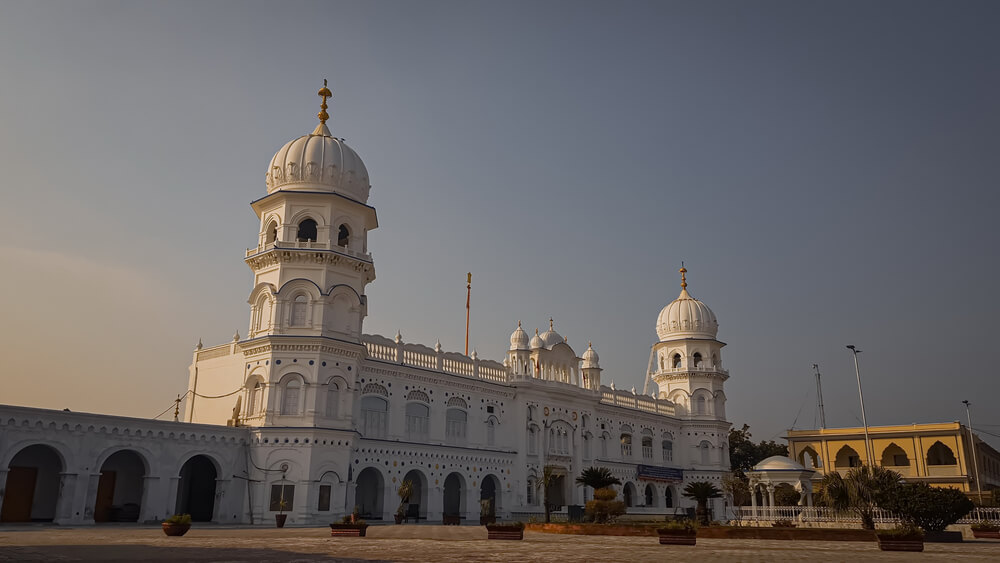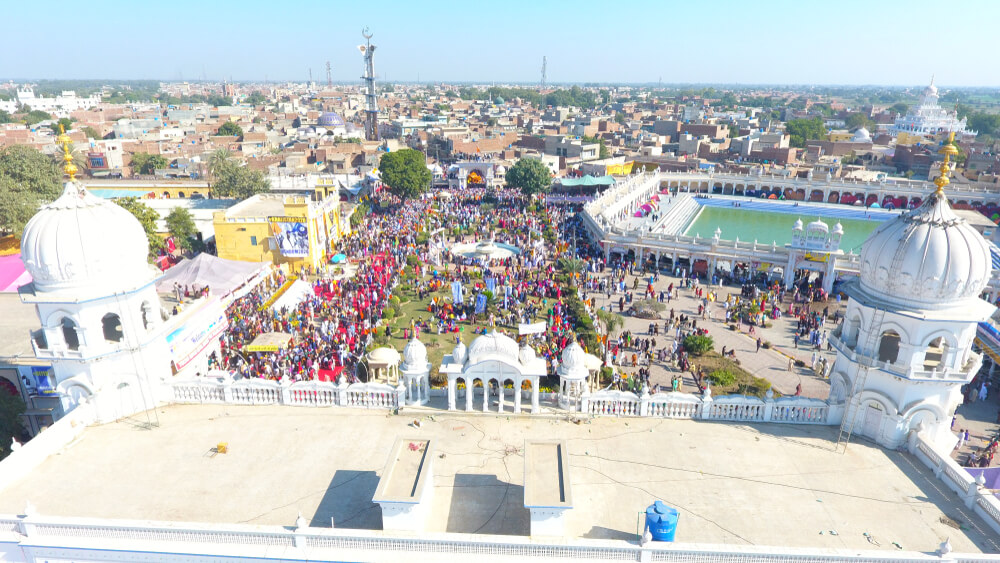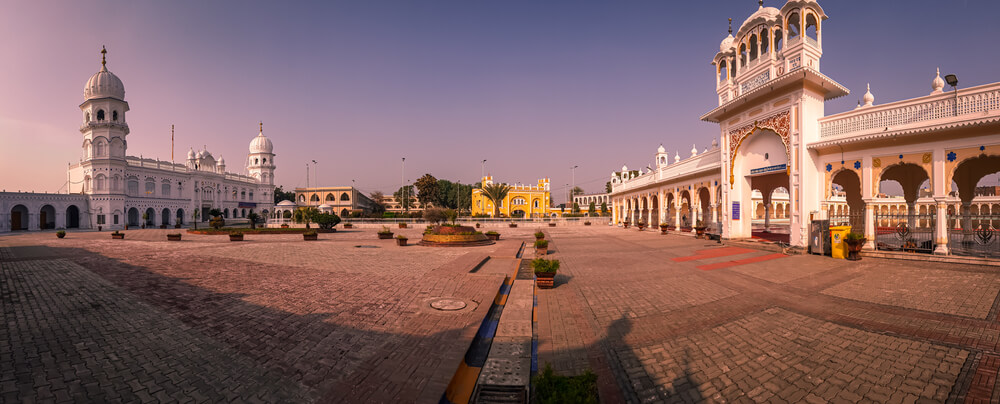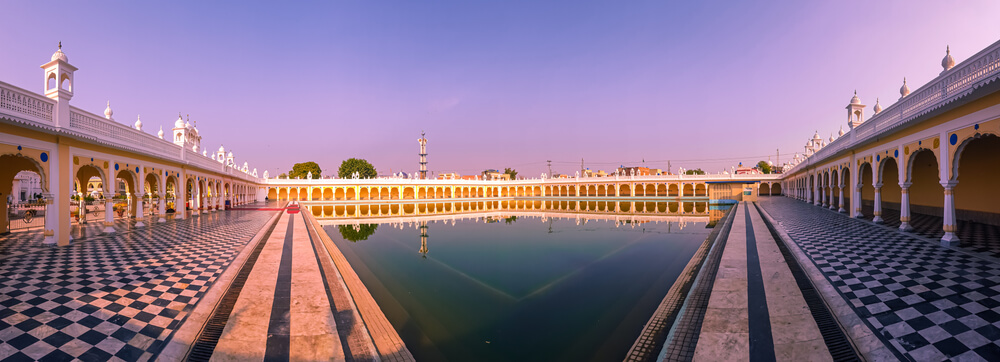Gurdwara Janam Asthan Nankana Sahib
Have you ever visited a Sikh temple before? What was your experience like? If you’re a tourist in Pakistan and want to experience some of the local Sikh cultures, a visit to Gurdwara Janam Asthan Nankana Sahib is a must.
This holy shrine is where Baba Guru Nanak, the founder of Sikhism, was born. It’s an important place for Sikhs worldwide and draws visitors from all religions. The architecture and decor are beautiful, and it’s a peaceful place to reflect on your beliefs.
Due to the rise in religious tourism, Pakistan has been deemed one of the world’s hottest and best tourist destinations. The Sikh community resides here in peace, enjoys its rituals and festivals, and welcomes Sikh believers and non-believers who wish to visit the tombs of Sikh saints.
Following in his footsteps, 10 Gurus emerged in Sikhism, whose teachings are widely followed in Pakistan and admired by members of various faiths.
Therefore, Gurdwara Nankana Sahib may be a holy site for Sikhs, but it also has sentimental meaning for those of other faiths who frequently come to the location. In October of 2019, here, Prime Minister Imran Khan set the foundation for Nankana Sahib University.
The History of Nankana Sahib, Lahore
The city was built in the fourteenth century by Rai Bhoi, a Muslim Rajput from the Bhatti tribe. Before Baba Guru Nanak was born, the city was known as Rai-Bhoi-Di-Talwandi. After the birth of Guru Nanak, Rai Bular Bhatti, the great-grandson of Rai Bhoi, was renamed the city Nanak Ana, or Nankana.
The name Sikh comes from the term Seekhna, which means education and learning. It is claimed that the Gurdwara Nankana Sahib was established in 1600 CE after the death of Baba Guru Nanak. In 1819–20 CE, the Gurdwara was restored by Maharaja Ranjit Singh (1780–1839), also known as the Lion of Punjab (Sher-e-Punjab).

In 1921, the Gurdwara Reform Movement (Akali Movement) caused friction within the community and resulted in the infamous slaughter of Akali protestors. The protest lasted until the Sikhs regained control of the Gurdwara.
Western Punjab dominated a Muslim-populated region and backed Pakistan’s independence. Most Sikhs and Hindus moved to India, whereas most Indian Muslims migrated to Pakistan.
Exciting Facts About Nankana Sahib
1. The Gurdwara Nankana Sahib, Pakistan, was built in 1600 CE. The Gian Punjab Maharaja Ranjit Singh, the Sikh Conference of Punjab, Jammu, Kashmir, Peshawar, Kangra, and Hazara repaired it between 1819 and 1820 CE. Its history stretches back to 1849, when the British assumed control of Punjab after Hindus began seizing Sikh Gurdwaras.
2. During the British administration, the Gurdwara Janam Asthan was the location of a violent incident in which more than 130 Akali Sikhs were murdered in 1921 after the shrine’s Mahant attacked them. The episode is seen as a significant turning point in the Gurdwara Reform Movement, which resulted in the passage of the Sikh Gurdwara Act in 1925 and terminated the Mahant’s power over Gurdwaras. In 2014, Pakistan constructed a memorial for the massacre.
3. Gurdwara Nankana Sahib is a revered gurdwara constructed on the place where Guru Nanak, the founder of Sikhism, is said to have been born. The shrine is located in the Pakistani province of Punjab, in the city of Nankana Sahib, close to Lahore. It is said that Gurdwara Janam Asthan is situated on the spot where Guru Nanak was born to Mehta Kalu and Mata Tripta.
4. Nankana Sahib was formerly called Talwandi, and a wealthy landlord named Rai Bhoi founded it. In honor of the Guru, Rai Bhoi’s grandson, Rai Bular Bhatti, renamed the town Nankana Sahib. After the birth of Guru Nanak Sahib, the term ‘Sahib,’ of Arabic origin, became a term of respect.
5. The region surrounding Nankana Sahib was previously a tehsil within the Sheikhupura District. To stimulate development in the area, the provincial government elevated Nankana Sahib to district rank in May 2005.
6. Guru Nanak, born in the city, was the first Sikh Guru and the first to preach here. Guru Nanak is supposed to have been born in 1469 and founded Sikhism.
7. The Gurdwara is one of nine significant gurdwaras in Nankana Sahib. Sikh Yatris routinely visit the shrine as part of a pilgrimage route in Pakistan.
The Architecture of Nankana Sahib
The Gurudwara consists of two buildings: the Darbar Sahib (main hall) and the Langar Sahib (kitchen). The Darbar Sahib is decorated with stained glass windows, paintings of Sikh saints, and a marble floor. The Langar Sahib serves free meals to all visitors, regardless of religion or social status. Nankana Sahib is also home to many historical sites, including the Nankana Sahib Museum and the Nanak Jhira (water spring).

Every year, thousands of Sikhs from around the world visit Nankana Sahib to pay homage to Guru Nanak Dev Ji.
Birthday Event of Baba Guru Nanak
Baba Guru Nanak’s birthday is celebrated yearly at the gurudwara with great enthusiasm. Travelers from all over come to pay their respects and receive his blessings. The atmosphere is always festive, with music and dancing.
Baba Guru Nanak is considered a great saint and prophet of Sikhs, and his birthday is a special occasion for Sikhs worldwide.
On this day, Baba Guru Nanak is said to have been born in 1469. He was a great teacher and spiritual leader; his teachings have inspired people for centuries. Baba Guru Nanak’s birthday is a time to celebrate his life and work and give thanks for his education.
Attractions Offered By Nankana Sahib
Gurdwara offers a wide range of attractions to its visitors. So, if you are interested, read on!
Majestic Building of Nankana Sahib
When you are there, your eyes will first see the Majestic Building of Nankana Sahib. The Majestic Building was constructed in 1886 by the Sikh Maharaja Ranjit Singh.
It is a large complex with a temple, a library, and a museum. The building is integral to the city’s history and culture and attracts tourists worldwide.

Thousands of travelers visit the Majestic Building yearly to pay homage to the city’s Sikh heritage. The building is a symbol of the rich cultural diversity of Pakistan, and it stands as a testament to the religious tolerance of the Sikh community.
Main Square
The main square of Nankana Sahib is a beautiful open space surrounded by pink sandstone buildings. In the center of the square stands a magnificent marble gurdwara, or Sikh temple. Two green parks flank the Gurdwara, and its white walls are decorated with intricate gold calligraphy. This central square is a powerful reminder of the incredible history of their religion.
Holy Water Pool ( Saroor Sahib)
Nankana Sahib is home to some holy sites, including the Saroor Sahib or Holy Water Pool. The pool is situated within the Nankana Sahib Gurdwara complex and is said to have been built by Guru Nanak Dev Ji. The pool’s water is believed to have healing properties and that drinking from it can cure diseases.
Thousands of Sikhs and pilgrims from around the world visit Nankana Sahib each year to take a dip in the Saroor Sahib and partake of its holy water.
Palki Sahib Nankana Sahib
One of the most significant sites in Nankana Sahib is the Palki Sahib, a beautiful wooden structure that houses a sacred relic of Guru Nanak. The Palki Sahib is a place of great reverence for Sikhs, and it is tradition for pilgrims to circumambulate the structure three times before paying their respects.
For many Sikhs, a visit to Nankana Sahib is a once-in-a-lifetime experience, and the Palki Sahib is an essential part of that journey.
Mandap
One of the most popular attractions at Nankana Sahib is the Mandap, a large covered structure built in honor of Guru Nanak Dev Ji. The Mandap is decorated with beautiful Sikh art, and its central location makes it a perfect place for pilgrims to rest and pray. In addition to its religious significance, the Mandap is a popular spot for weddings and other celebrations.

Whether a pilgrim or a tourist, visiting the Mandap at Nankana Sahib is a memorable experience.
Historical Jand Sahib ( Huge Memorial Tree)
One of the most notable is the Jand Sahib, a massive tree in the Gurdwara’s center. Local legend says that the tree was planted by Guru Nanak, the founder of the Sikh religion, and has been growing for over 500 years.
Today, the Jand Sahib is a popular pilgrimage site for Sikhs from all over the world. Thousands of visitors visit Nankana Sahib annually to pay their respects to this sacred tree.
Depiction of Sardar Lachhman Singh’s Brutal Murder.
On February 21, 1921, Sardar Lachhman Singh led an army of 200 Sikhs to Gurdwara Janam Asthan to reclaim it from the Mahants.
Naryan Das Mahant and his followers, however, brutally slaughtered the Sikhs. Sardar Lachhman Singh was bound to a tree (which currently stands in the center of the memorial) and then burned to death. The Sikhs ultimately succeeded in reclaiming the Gurdwara due to this historical sacrifice. Consequently, Sikh believers hold the memorial in high regard.
One of the memorial walls depicts the terrible death of Sardar Lachhman Singh, a continual reminder of the enormous sacrifices made by Sikh leaders to protect the sanctity of their holy sites.
A few steps in front of the memorial, in the heart of the main square, the gilded Sikh Shaheedi rises tall within a glass enclosure. The Shaheedi was founded to commemorate the February 21, 1921 event, whose final salutations were conducted at this location.
Beautiful Painting of Baba Guru Nanak Dev With Two Close Companions
Sikh art often depicts Baba Guru Nanak Dev, the founder of the Sikh religion, with his two close companions – Bhai Bala and Bhai Mardana.
This painting is a beautiful example of this type of Sikh Art. The three figures are shown in conversation, with Guru Nanak Dev seated in the middle and his companions on either side. The painter used bright colors and rich detail to capture the scene. The setting appears to be Nankana Sahib, the birthplace of Guru Nanak Dev.
The painting is a reminder of the close friendship between the three men and their shared commitment to spreading the Sikh message. A feeling of peace and serenity comes from looking at the painting as if you’ve been transported to a different time and place. It’s truly a work of art worth it if you’re ever in Punjab.
Langar Khana ( Dining Room) Nankana Sahib
‘Langar’ means ‘free meal’ in Punjabi, and ‘khana’ means ‘house.’ The langar khana at Nankana Sahib is open to all, regardless of caste, creed, or religion. It is a place of equality where everyone sits together on the floor to eat.
Guru Nanak Dev Ji started this concept of langar to challenge the caste system and promote social harmony. Over time, it has become an essential part of Sikh culture and tradition.
Every day, thousands of people from around the world come to Nankana Sahib to experience the langar khana.
Gurdwara Janam Asthan
The city is home to the Gurdwara Janam Asthan, which marks the birthplace of the Sikh founder Guru Nanak Dev. The Gurdwara is an important pilgrimage site for Sikhs from all over the world, and it attracts visitors of all faiths. The gurdwara complex is spread over about 20 acres and includes several shrines and temples.
Visitors to the complex can enjoy various activities, such as participating in prayer services, listening to religious lectures, or simply exploring the beautiful grounds.
Whether you are a yatri or a tourist, a visit to Nankana Sahib will be a memorable experience.
Vast Sitting Area for Devotees Nankana Sahib
The site is home to several historic buildings, including a vast sitting area for devotees. The sitting room, which can accommodate up to 5,000 people, is surrounded by a low wall and has the main entrance gate.
Many smaller gates lead to the various shrines and temples on the site. The sitting area is open to the sky and is covered with a white marble floor.
Devotees can sit on the floor or on one of the many benches that line the perimeter of the area. A sitting room is a peaceful place where Sikhs can reflect on their faith and connect with other community members. It’s also a site where you can learn more about Sikhism and its rich history.
The Story of 5 Ks
The 5 Ks trace back to Guru Gobind Singh’s founding of the Khalsa Panth in 1699. The combination of the 5Ks signifies that the Sikh who wears them has dedicated their life to Guru devotion and surrender. The 5 Ks are five physical emblems worn by Sikhs who have received Khalsa initiation.
Kesh (Uncut Hair)
The hair (kesh) represents both holiness and strength. Maintaining uncut hair signifies a willingness to embrace God’s gift as intended. Means the acceptance of a modest lifestyle and the rejection of pride in one’s looks. A Sikh must only bow to the Guru, not to a barber. It is after the appearance of Guru Gobind Singh.
Kara (A Steel Bracelet)
A symbol of moderation. A sign that God has no beginning and no end. Being a link in the chain is a symbol of permanent community connection. Because it is not an adornment, the Kara is constructed of steel instead of gold or silver.
Kangha (A Wooden Comb)
This represents a clean mind and body, as the uncut hair is neat. It means the significance of caring for the body God created; since the body is a vehicle for enlightenment, proper care should be taken of it.
Kachera (Cotton Shorts)
This pair of trousers must not extend below the knee. It was suitable clothing for Sikh fighters of the 18th and 19th centuries, as it was ideal for horseback battles. It is a sign of humility.
Kirpan (Steel Sword)
There is no standard Kirpan design, and its length might range from a few inches to three feet. It is sheathed and may be worn over undergarments. The Kirpan can symbolize spirituality, the defense of the good and the weak, and God.
Nankana Sahib Lahore Ticket Price
Nankana Sahib is open to all visitors, and there is no entry fee. However, donations are appreciated.
Nankana Sahib Timings & Visiting Days
The Nankana Sahib is open daily from sunrise to sunset. It is open for visitors from 8:00 AM to 4:00 PM every day of the week.
Location of Nankana Sahib
Address: Buchey Ki Rd, Nankana Sahib, Punjab
Phone: 0300 4982495
Conclusions
Gurdwara Nankana Sahib is a very significant location for Sikhs, and it is highly recommended that you pay a visit there. It will be an incredible event for you and a potent reminder of Sikh history and tradition simultaneously. The people who live there are pretty kind and hospitable.
FAQs
1. Where is Nankana Sahib Situated?
Nankana Sahib is situated in the Nankana District, Punjab Province of Pakistan.
2. Is Kartarpur Sahib and Nankana Sahib same?
Kartarpur Sahib is located in Narowal, whereas Nankana Sahib is in Nankana, Pakistan.
3. Why is Nankana Sahib in Pakistan?
Nankana Sahib is in Pakistan because it is the birthplace of Guru Nanak Dev Ji.
4. How to Reach Nankana Sahib?
The best way to reach Nankana Sahib is by road. Some buses and coaches travel from different parts of the country to Nankana Sahib.
